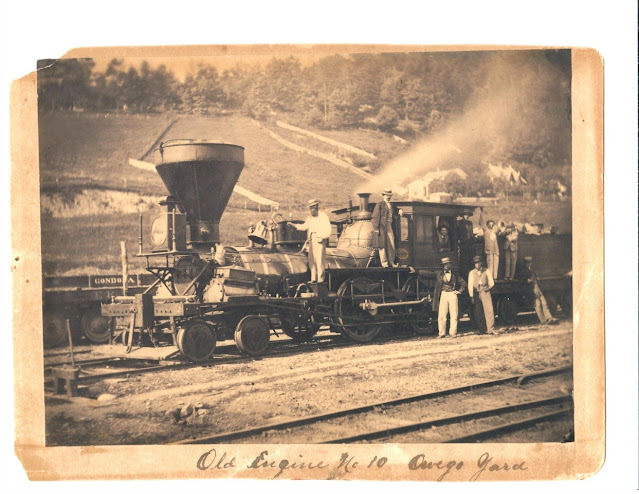The first Erie station in Owego as it appeared in 1851.
When the Erie Railroad was Opened to Owego
By Richard F. Palmer
When the New York and Erie Railroad opened from its original eastern terminus of Piermont, in eastern New York, to Goshen, the first train was hauled by Locomotive No. 4, the Orange. It took the road 10 more years to reach the western terminus at Dunkirk, N.Y., on Lake Erie. The Orange had a colorful history. It was stolen once, and was transported to construction sites over three canals, two rivers and three bays. The engine’s dimensions were: cylinders 10 3/4" x 18", and 50-inch drivers. It weighed 30,700 pounds. It was of the 4-4-0 wheel arrangement.
It was shipped by water from Philadelphia to Piermont and was one of three engines ordered from William Norris of Philadelphia, Pa., and delivered to the Erie railroad in January, 1841.They were shipped by boat from Philadelphia to Piermont. The other two were the Eleazor Lord and the Ramapo. In the early years of railroading it was common to transport locomotives on boats to the railhead.
Erie locomotive OrangeBut it was through its adventures that the Orange, named for Orange County New York, carved a permanent niche in the early history of the Erie. Aside from pulling work trains, this seemingly common engine managed to find itself at the front of the first trains over newly-completed sections of the line across the Southern Tier of New York State.
The engine did double duty. Aside from hauling construction trains it traditionally pulled the first official train into a community while the railroad was pushed westward across New York State. A locomotive was needed to haul construction trains from Binghamton west. The Orange was forwarded by boat up the Hudson River to Albany, thence by Erie Canal to the junction with the Chenango Canal, and on to Binghamton. The trip took five weeks. It was unloaded from a canal boat at the old State Street dock, and placed on the tracks late in October, 1848.
Tracklaying between Binghamton and Owego was completed on May 31, 1849. The following day an excursion train arrived from New York, bearing distinguished guests, was run as far as Binghamton on May 31st, and on the next morning the Orange, along with one other engine, did the honors of pulling the first train into Owego, arriving there at 10 a.m. amid cannon fire and a chorus of church bells. Considerable preparation had been made to celebrate this long-awaited occasion.
Several prominent local men were appointed “officers of the day” to make arrangements for the celebration. Thomas Farrington was named president. Vice presidents for the day were attorneys John M. Parker, Ezra S. Sweet, and John J. Taylor; and Franklin Slosson, Tioga County Treasurer. Colonel Nelson W. Davis was marshal. A dinner for the invited guests was served in the big dining-room of the depot (Owego having been designated as a dining station). A large “public feast” was held outside the depot, catered by D. B. Dennis, proprietor of the Tioga House, located near the corner of Main street and North avenue.
Farrington, a prominent educator, made the welcoming speech. He introduced distinguished guests who had arrived aboard the first train, including several railroad officials and newspapermen. The event was covered by numerous newspapers. “The approach (of the train) was very exciting,” wrote the editor of the Owego Gazette. “The whole country was gathered there waiting the arrival of the train - and for a mile or more this side of the village, companies of men, women and children were stationed along the road to greet the welcome event. A large hill in front of the depot and partially covered by trees was occupied by many picturesque groups who sent to us by the waving of handkerchiefs a salvation which their voices could not convey so far; the same signal waved from every window in the vicinity, while the vast crows assembled in the area about the depot cheered, and the cannon was tied off, all in a most appropriate manner.”
One of the guest speakers was Erie railroad official William E. Dodge. He said 20 years previous he left Harford, Conn. and traveled to Owego by stagecoach. He said he was so exhausted by the time he arrived he resolved he would “never venture over the hills by stage again.” All the speakers said the coming of the railroad was a marvel and would put Owego on the map. Prior to the coming of the railroad, one speaker noted, “it was considered a good day’s work to drive to Binghamton and back.”
The Orange, among the first Erie engines ever built, lasted into the 1870s and was renumbered “401.” It was eventually scrapped in Susquehanna. J. C. Haggett, an early locomotive engineer on the Erie, said it was exhibited for several years there, protected in a special constructed glass case. There came a time, however, when an unsentimental master mechanic decided that the Orange had lingered long enough and had it scrapped.
The Orange thus disappeared into oblivion after for being so long the Erie's "mascot" of being in the forefront during construction of many lines of the New York and Erie in New York and Pennsylvania.
The Erie continued on west and was opened from Owego to Elmira on Oct. 2, 1849; Elmira to Corning, Jan. 1, 1850; and completed to Dunkirk on April 22, 1851.
This is one of the oldest known photos of an early Erie locomotive (No. 10) built by William Norris in November, 1847 12 1/2” x 26” cylinders 60” drivers, weight 26,880 lbs on drivers, outside connected. Erie locomotive statement of Decembrer 26, 1861 said “switching Owego Yard.” Maintained at Susquehanna shops. Retired by 1875. (Railway & Locomotive Historical Society Bulletin #131, Autumn, 1974, P. 33) Tioga County Historical Society collection






